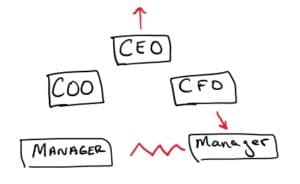
“To the extent that leaders deal with challenges by focusing on the impacting agent or condition (content), they usually remain stuck as a result. More mature leaders focus primarily on their own response to a problem (process)”. Edwin Friedman
A leaders anxiety response to a threat or opportunity generates tension in the organization. A leader who is aware of the tension (content) but unaware of the process which produced it is vulnerable to implementing quick fixes. These solutions may appear logical on the surface, but underneath the primary driver is managing his/her own anxiety.
Tension activates 4 main observable relationship patterns:
Distance
Distance can take on many forms in the organization. From employees just not communicating with each other to functional departments not sharing information with each other. This is often referred to as organizational silo’s where the leaders are more interested in protecting their turf than working towards the overarching goals of the organization.
In the nuclear family, either the wife or the husband distances in order to manage the tension in the relationship. This distance may show up as a physical separation, one of the spouses always at the office or out with friends. Conversations are superficial and lack any depth.
Conflict
As tension increases in the organization conflict may erupt. Blame and fault-finding are prevalent.
As tension rises in the nuclear family husband and wife may externalize it into the relationship. Each focuses on what is wrong with the other and attempts to change the other. The process leads to resentment.
Symptoms
Symptoms of tension in the workplace can include an unusually high number of sick days being taken, gossip, high turnover rates, low morale etc.
Tension in the nuclear family can result in one of the spouses developing a physical illness, mental illness or addiction.
Projection
One of the ways that organizations deal with tension is scapegoating. Projection of the blame onto one individual, problem client or customer relieves the tension in other members of the team.
In the nuclear family, tension may be projected onto one or more children. The parents worry excessively about the child. This over-focus on the child results in symptom development which confirms and exacerbates the worry, which in turn inflames the symptoms, which increases the worry. A vicious cycle. Rather than tension relief manifesting through marital conflict, distancing or impairment of a spouse, it has found a relief valve in the child.
~~~~
How did your family of origin manage tension? Did one of the patterns dominate? What pattern do you most often observe in our own functioning when tension goes up?
Consider the CEO who observes conflict between two managers in the organization. A leader thinking in a linear way, orientated towards blame may deal with the conflict (content) and make a move to resolve the problem. The quick fix, at best, provides temporary relief but won’t address the underlying process.
The CEO who is thinking systems with a responsibility orientation may see the process unfolding. Rather than implementing quick fixes this leader has been working towards developing greater levels of emotional maturity. She recognizes that like her father, she tends to distance when tension gets high. This tension is felt by the CFO who projects blame onto a manager. The COO develops an ulcer. Conflict erupts between two managers. By asking herself “What’s really going on here?” and “What part do I play?” rather than opting for a quick fix and focusing on the conflict between managers (content) the CEO recognizes the process and works to re-establish connection with her direct reports, the system calms down. A tense leader cannot lead the organization out of a tense state.






